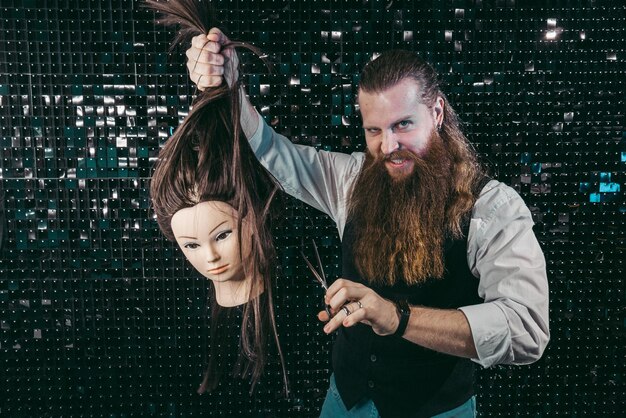The Remake Debate: When Should a Classic Be Reimagined?

The Remake Debate: When Should a Classic Be Reimagined? explores the delicate balance between honoring cinematic history and breathing new life into beloved stories, examining the motivations, successes, and failures of reimagining classic films for modern audiences.
The world of cinema is filled with classics, films that have stood the test of time and continue to resonate with audiences. But what happens when Hollywood decides to revisit these cherished stories? The Remake Debate: When Should a Classic Be Reimagined? is a question that sparks passionate discussions among movie lovers.
Understanding the Allure of Remakes
Remakes are a constant presence in the film industry. They offer studios a chance to capitalize on existing intellectual property, leverage nostalgia, and introduce beloved stories to new generations. But understanding the allure of remakes goes beyond mere financial incentives.
Nostalgia and Familiarity
Nostalgia plays a significant role in the appeal of remakes. Audiences often feel a connection to the original films and are curious to see how their favorite stories are updated for a modern context. This pre-existing familiarity can translate into box office success.
Introducing Classics to New Audiences
Remakes can also serve as a bridge, introducing classic films to younger viewers who may not have otherwise discovered them. By updating the story with contemporary themes and visuals, remakes can make older films more accessible to a new generation.
- Expanding the film’s universe with prequels or sequels.
- Modernizing the setting and updating the costumes and gear to fit current times.
- Exploring character backstories in greater detail.
- Integrating current social and political themes.
Ultimately, the allure of remakes lies in the blend of nostalgia, familiarity, and the opportunity to reimagine classic stories for a new era. When done well, remakes can revitalize beloved films and introduce them to a wider audience. But the road to success is paved with potential pitfalls.
The Pitfalls of Remaking a Classic
While the allure of remakes is undeniable, the path is fraught with challenges. Reimagining a classic film requires a delicate balance between honoring the original and bringing something new to the table. Missteps can lead to disappointment and alienate fans of the original.
Disappointing Loyal Fans
One of the biggest risks of remaking a classic is disappointing loyal fans. Changes to the story, characters, or tone can be met with resistance, especially if the remake fails to capture the essence of the original. Staying true to the spirit of the source material is crucial.
Failing to Justify the Remake
A remake should have a clear purpose. Simply recreating the original without adding anything new or meaningful is often seen as a pointless exercise. A successful remake offers a fresh perspective, explores new themes, or updates the story for a modern context.

The pitfalls of remakes are numerous, ranging from disappointing loyal fans to failing to justify the remake’s existence. When a remake stumbles, it often faces harsh criticism and struggles to find an audience. Understanding these potential problems is important for any filmmaker considering revisiting a classic.
Successful Examples of Reimagining Classics
Despite the potential pitfalls, some remakes have managed to succeed, earning both critical acclaim and commercial success. These films demonstrate that it is possible to reimagine a classic in a way that honors the original while offering something new and valuable.
“The Departed” (2006)
Martin Scorsese’s “The Departed” is a remake of the Hong Kong film “Infernal Affairs.” While it follows the same basic plot, “The Departed” transplants the story to Boston and infuses it with Scorsese’s signature style and themes. The result is a critically acclaimed film that stands on its own merits.
“True Grit” (2010)
The Coen Brothers’ “True Grit” is another example of a successful remake. While it is based on the same novel as the 1969 film, the Coen Brothers brought their own unique sensibility to the story, creating a darker and more nuanced Western.
- A talented and dedicated cast.
- Well-written dialogue.
- A commitment to staying true to the spirit of the original while introducing fresh perspectives.
- Captivating cinematography.
Successful remakes offer a fresh perspective, explore new themes, or update the story for a modern context, all while honoring the spirit of the original. These examples demonstrate that remakes can be a valuable addition to the cinematic landscape when approached with care and creativity.
When Should a Classic Be Reimagined? Key Considerations
The question of when a classic should be reimagined is complex and multifaceted. There’s no one-size-fits-all answer, but there are several key considerations that filmmakers and studios should keep in mind.
Is there a compelling reason for the remake?
A remake should have a clear purpose beyond simply capitalizing on nostalgia. Does the new version offer a fresh perspective, explore new themes, or update the story for a modern context? If not, the remake may not be worth pursuing.
Does the original film have flaws that can be improved upon?
Sometimes, a remake can be an opportunity to address shortcomings in the original film. This could involve clarifying plot points, developing characters more fully, or updating the film’s visual style. However, it’s important to avoid changing elements that are essential to the original’s appeal.
In conclusion, the decision to remake a classic film should not be taken lightly. It requires careful consideration of the motivations, the potential pitfalls, and the specific qualities of the original film. When approached with respect, creativity, and a clear purpose, remakes can be a valuable addition to the cinematic landscape.
The Role of Technology in Modern Remakes
Technology has played a significant role in shaping modern remakes. Advancements in visual effects, CGI, and digital filmmaking have opened up new possibilities for recreating classic stories, but they also raise questions about the importance of practical effects and the authenticity of the filmmaking process.
Visual Effects and CGI
Visual effects and CGI have become essential tools in modern filmmaking. They allow filmmakers to create stunning visuals and bring fantastical worlds to life. However, the overuse of CGI can sometimes detract from the emotional impact of a film.
The Importance of Practical Effects
While CGI has its place, many filmmakers still value the use of practical effects. Practical effects can add a sense of realism and authenticity to a film that CGI sometimes struggles to achieve. A balance between the two is often the best approach.
- 3D modeling and rendering.
- Motion capture technology.
- Virtual reality (VR) experiences.
- Artificial intelligence (AI) for character animation.
Technology has undoubtedly transformed the landscape of filmmaking, but it’s important to remember that technology is simply a tool. The most successful remakes use technology to enhance the story, not to replace it. The human element, the acting, and the storytelling still play a vital role in creating a memorable and engaging movie.
Audience Expectations, cultural context, and Ethical Considerations
The realm of movie remakes is heavily influenced by audience expectations, cultural context, and various ethical considerations that come into play when reinterpreting a classic. These factors greatly influence a remake’s reception and overall impact.
Impact of Expectations
Audience expectations are a critical factor that can make or break a remake. Often, viewers approach remakes with a sense of nostalgia for the original, hoping to see a respectful homage while also being curious about any new elements the remake might introduce. Successfully navigating these expectations requires a deep understanding of what made the original so beloved and finding a balance with modern sensibilities.
Cultural Significance
Cultural context is another essential component. Movies gain cultural importance over time, capturing the moods, struggles, and triumphs of different eras. A remake that is insensitive to this context or alters it without good reason can face severe backlash. Paying attention to these nuances ensures that the essence and legacy are honored.
Ethical questions also play a significant role like:
- Ensuring creative teams respect and understand cultural heritage, promoting diversity both on and off camera.
- Transparency about adapting material from its predecessors.
- Acknowledging source material properly.
Understanding the audience’s needs while considering the ethics involved helps filmmakers create remakes that not only retell stories but also connect with contemporary morals on a deeper level––making stories both appealing and socially thoughtful for modern viewers!
| Key Aspect | Brief Description |
|---|---|
| 🤔 Purpose of Remake | Should offer a fresh perspective or update to new audience |
| 🎭 Audience Expectations | Balancing homage with something new to avoid disappointing loyal fans. |
| 🎬 Technological Impact | Modern technology offers fantastic visuals but should maintain practicality. |
| 🌍 Cultural Respect | Honor original themes/struggles; adapt sensitively without erasing meaning. |
Frequently Asked Questions
▼
A successful remake typically respects the source material while providing a fresh perspective, enhanced visuals, or deeper character development. It should also justify its existence by offering something new.
▼
Audience reactions vary. Loyal fans of the original can be critical, while new viewers may appreciate the updated version. Remakes often face scrutiny and must win over both groups to succeed.
▼
Common issues include disappointing loyal fans, failing to add anything new, and misinterpreting the original’s themes. Over-reliance on CGI at the expense of practical effects can also be a problem.
▼
New technology like CGI and advancements in filming can enhance visuals but cannot replace good storytelling. Balancing new technology with practical effects maintains movie magic for audiences.
▼
Filmmakers remake classics to introduce familiar stories to new generations, update outdated elements, or provide new viewpoints. This approach offers a chance to capitalize on nostalgia as well.
Conclusion
Ultimately, the decision to reimagine a classic film is a complex one, fraught with both opportunities and risks. By carefully considering the key factors outlined in this article, filmmakers can increase their chances of creating a remake that honors the original while offering something new and valuable to audiences.





